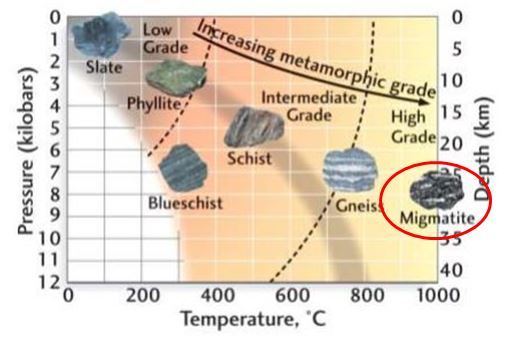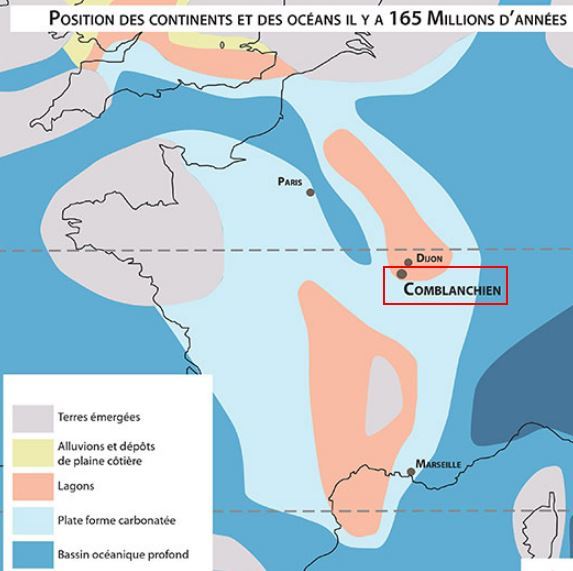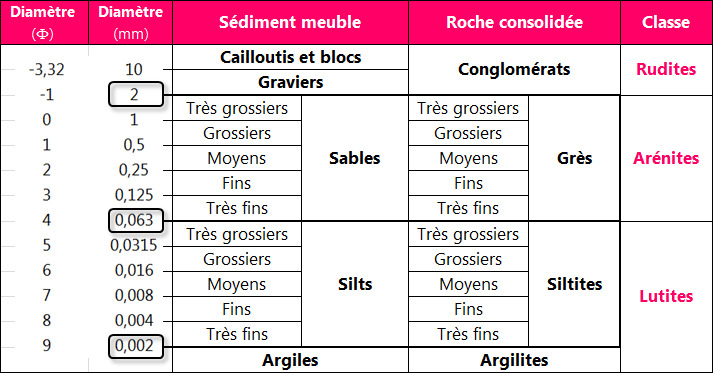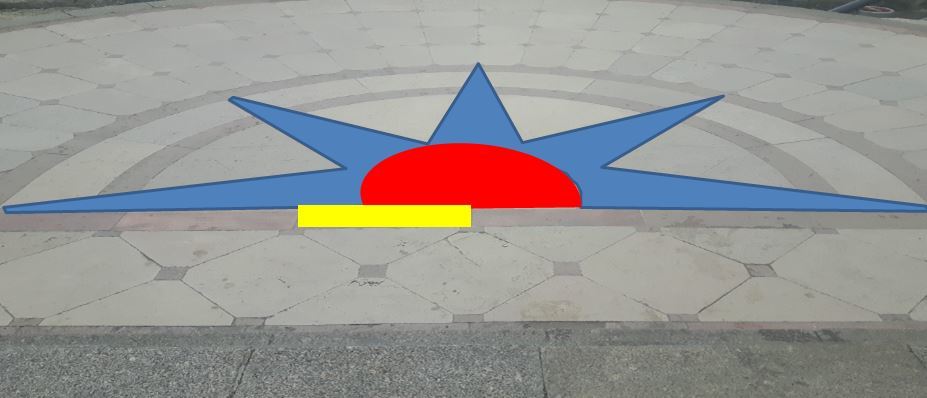
La Earthcache / The Earthcache
A l'extrémité de la place des Quinconces, un ensemble architecturale, le monument aux Girondins, constitue une parfaite zone d'observation de différentes formations et phénomènes géologiques.
Ce premier épisode va nous permettre de découvrir et caractériser les différentes roches constituant le dallage de l'étoile de la terrasse ouest.
► La Migmatite
La Migmatite est roche métamorphique, c'est à dire une roche secondaire issue de la métamorphisation (transformation sous l'effet de la pression et de la température) d'une roche primaire, qu'on va appeler protolithe.
Les migmatites sont associées à un métamorphisme de haut degré ; il s'agit du stade ultime de métamorphisation (Hautes Pressions et Hautes Températures), avant fusion complète de la roche et transformation en un magma crustal à l'origine d'un granite d'anatexie.

Il existe, deux types de migmatites selon leur niveau de fusion :
~ Les Métatexites
Les métatexites sont un premier stade de migmatites, dans lesquelles les structures n'ayant pas subi de fusion partielle (les paléosomes) sont larges et prépondérantes.
Ces formations se présentent sous une forme rubanée, avec une alternance de lits clairs (partie de la roche ayant fondu) et de lits sombres (partie de la roche étant restée solide).
Cette roche très ductile présente des foliations avec des formes très variées, dont la foliation pénétrative synmigmatitique caractéristique.

~ Les Diatexites
Les diatexites sont le stade le plus avancé de la métamorphisation de la roche ; ces diatexites ont un aspect granitique prononcé et perte de la foliation (originelle ou synmigmatitique).
Ces formations peuvent présenter des colorations très variées selon la nature du protolithe. Par exemple, la coloration rouge de la roche est due à une forte présence dans celui-ci d'un minéral riche en fer, l'hématite.

► Le calcaire marbrier du Comblanchien
Le calcaire du Comblanchien est une roche sédimentaire biodétritique, en partie métamorphisée.
Il est issu du dépôt au Jurassique (il y a 160 millions d’années) de débris dans une mer qui recouvrait l'actuelle Bourgogne.
Il s'agissait d'un haut fond calcaire, comme les bancs actuels des îles Bahamas au large de la Floride. Des plages, des dunes de sables oolitiques ceinturaient un grand lagon dans lequel s’est élaboré le comblanchien avec ses divers faciès.

Il existe différents type de Comblanchien ; celui-utilisé pour l'étoile des Girondins est le Comblanchien Clair résultant d’une vase calcaire quasi dépourvue de fossiles ou de grains de sable.
Cela donne un calcaire au grain très fin, quasi-invisible à l'oeil nu, donc la matrice calcaire s'est métamorphisé en grains de calcites très finement cristallisées. On parle alors de texture micritique.
Sa couleur dominante est le beige pouvant varier du beige clair au beige marron, avec une grande variété de teintes.

► Une roche sédimentaire détritique
L'ensemble architectural de la pierre de l'étoile des Girondins présente un dernière formation géologique ; si sa nature et son origine sont plus difficiles à préciser, il est tout de même possible de la classifier selon un critère granulométrique.
Son observation montre qu'il s'agit d'une roche sédimentaire détritique partiellement métamorphisée, formée à l'origine par l'accumulation de débris d'origine terrigène (débris de roche) ou biogène (reste d'organisme vivants, entiers ou débris).
Dans cette famille de roche, la taille des débris agglomérés (qu'on appelle des clastes) constitue un critère de classification. Celle-ci peut être réalisée grâce à l'échelle de Wentworth.

At the end of the Place des Quinconces, an architectural ensemble, the monument to the Girondins, is a perfect area for observing different formations and geological phenomena.
This first episode will allow us to discover and characterize the different rocks constituting the star of the e pavement of the west terrace.
► Migmatite
Migmatite is metamorphic rock, that is to say a secondary rock resulting from metamorphization (transformation under the effect of pressure and temperature) of a primary rock, which we will call protolith.
Migmatites are associated with high-grade metamorphism; this is the ultimate stage of metamorphization (High Pressures and High Temperatures), before complete melting of the rock and transformation into a crustal magma at the origin of granite of anatexis.
There are two types of migmatites depending on their level of fusion:
~ Metatexites
Metatexites are a first stage of migmatites, in which structures that have not undergone partial fusion (paleosomes) are large and predominant.
These formations are in a banded form, with alternating light beds (part of the rock having melted) and dark beds (part of the rock remained solid).
This very ductile rock has foliations with very varied forms, including the characteristic synmigmatitic penetrating foliation.
~ Diatexites
Diatexites are the most advanced stage of rock metamorphism; these diatexites have a pronounced granitic appearance and loss of foliation (original or synmigmatitic).
These formations may have very varied colorations depending on the nature of the protolith. For example, the red coloring of the rock is due to a strong presence in it of an iron-rich mineral, hematite.
► Marble limestone from Comblanchien
Comblanchien limestone is a partially metamorphosed, biometritic sedimentary rock.
It comes from the deposit in the Jurassic (160 million years ago) debris in a sea that covered the current Burgundy.
It was a high limestone bottom, like the current benches of the Bahamas off Florida. Beaches, oolitic sand dunes encircled a large lagoon in which was developed the comblanchien with its various facies.
There are different types of Comblanchien; the one used for the Girondins' star is the Comblanchien Clair resulting from a limestone mud which is almost devoid of fossils or grains of sand.
This gives a very fine grained limestone, almost invisible to the naked eye, so the limestone matrix has metamorphosed into finely crystallized calcite grains. This is called micritic texture.
Its dominant color is beige which can vary from light beige to brown beige, with a wide variety of colors.
► A detrital sedimentary rock
The architectural ensemble of the stone of the Girondins' star presents a last geological formation; if its nature and origin are more difficult to specify, it is still possible to classify it according to a granulometric criterion.
Its observation shows that it is a partially metamorphosed detrital sedimentary rock, originally formed by the accumulation of debris of terrigenous origin (rock debris) or biogenic (remains of living organisms, whole or debris).
In this family of rocks, the size of agglomerated debris (called clasts) is a classification criterion. This can be done using the Wentworth scale.

► Sources bibliographiques / Bibliographical sources
Les Questions / The Questions
La lecture attentive du descriptif de la cache, ainsi qu'une observation des éléments de terrain et un peu de déduction sont normalement suffisants pour répondre aux questions de cette EarthCache.
A careful reading of the description of the cache, as well as observation of terrain features and some deduction is usually sufficient to answer questions of this EarthCache.
Questions pour valider :"Quinconc'EC 1 : Une Etoile et des Roches"
Questions to validate: "Quinconc'EC 1: A Star and Rocks"
Vous voici devant l'étoile qui orne la terrasse ouest de l'imposant monument aux Girondins (voir photo WP1).
Here you are in front of the star that adorns the west terrace of the imposing monument to the Girondins (see photo WP1).

- Question 1 : Etudier la roche de la zone bleue et déduisez-en sa nature et sa subdivision géologique (voir descriptif). Quelle est l'origine de la couleur de cette formation ?
- Question 1 : Study the rock of the blue zone and deduce its nature and its geological subdivision (see description). What is the origin of the color of this formation?
- Question 2 : Etudier la roche de la zone rouge et déduisez-en sa nature. Peut-on qualifier cette roche de micritique ? Justifier votre réponse.
- Question 2 : Study the rock of the red zone and deduce its nature. Can we call this rock micritic? Justify your answer.
- Question 3 : Etudier la roche de la zone jaune et déduisez en sa famille géologique. Utiliser l'échelle de Wentworth pour la caractériser.
- Question 3 : To study the rock of the yellow zone and to deduce in its geologic family. Use the Wentworth scale to characterize it.
Vous pouvez vous loguer sans attendre notre confirmation,
mais vous devez nous envoyer les réponses en même temps soit par mail via notre profil (
fafahakkai), soit via la messagerie geocaching.com (Message Center).
S'il y a des problèmes avec vos réponses nous vous en ferons part.
Les logs enregistrés sans réponses seront supprimés.Une photo de vous ou de votre GPS avec la colonne du monument aux Girondins en arrière plan sera la bienvenue, mais n'est pas obligatoire.
You can log this cache without waiting for our confirmation, but you must send us the answers at the same time, by e-mail via our profile (fafahakkai) or by the system of Message Center of geocaching.com.
If there is a problem with your answers we will notify you. The logs recorded without answers will be deleted.
A photo of yourself or your GPS with the Girondins Monument column in the background will be welcome, but is not mandatory.
Rappel concernant les « Earthcaches »: Il n'y a pas de conteneur à rechercher ni de logbook à renseigner. Il suffit de se rendre sur les lieux, de répondre aux questions ci-dessus et de nous renvoyer les réponses.
Reminder concerning "Earthcaches": there is neither a container to look for nor a logbook to sign. One need only go to the location, answer to the differents questions and send us the answers.